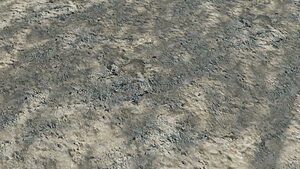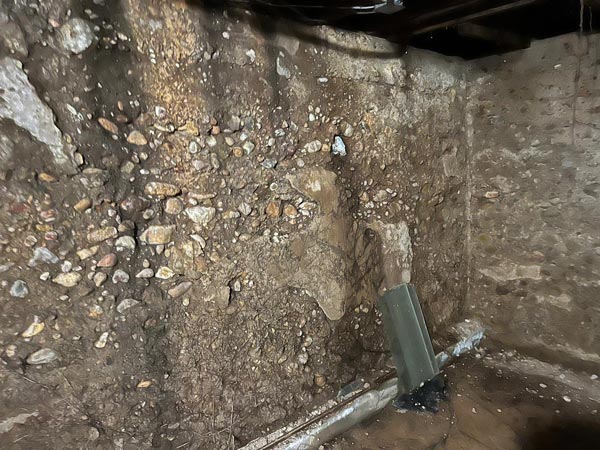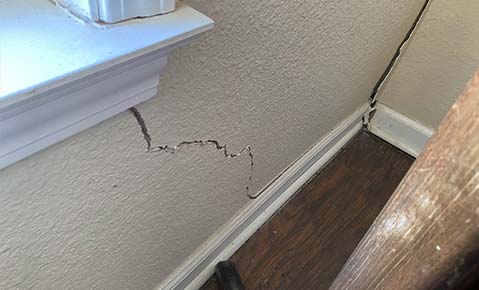Are you noticing that small chips or even large pieces of your concrete sidewalk, driveway, or patio are breaking off? If so, this is a sign that spalling might be occurring.
Spalling concrete is characterized by the flaking or peeling of the surface layer of a concrete structure. It typically appears as rough, exposed aggregate or as small, irregularly shaped pieces of concrete that have broken away from the larger surface. As the concrete chipping progresses, the exposed surface may become pitted or cracked, and the underlying steel reinforcement may become visible.
In this blog post, we’ll explore what causes chipping concrete and what repair solutions are available to restore your surfaces to their original condition.
What Do We Mean By Chipping Concrete?

Chipping concrete (or spalling concrete) refers to the flaking or chipping concrete surfaces such as sidewalks, driveways, patios, and pool decks. Once the surface of the concrete begins to chip, it continues to deteriorate rapidly, which can lead to structural concerns. Chipping concrete can also lead to trip hazards, especially in areas with heavy foot traffic.
What Causes Concrete To Start Chipping

Concrete chipping (i.e., spalling) can be caused by various things, including the following:
- Corroded rebar – When rebar corrodes, it expands, leading to the formation of cracks in the concrete and chipping. This weakens the structural integrity of concrete, making it susceptible to failure.
- Freeze-thaw cycle – Another factor that can cause concrete to spall is the freeze-thaw cycle. Concrete is porous, allowing water to seep in. When the temperature drops, the water inside the pores expands, creating pressure that can cause the concrete to crack and spall. The freeze-thaw cycle is particularly problematic in areas with cold winter months, where the temperature can fluctuate significantly. The constant cycle of moisture and freezing temperatures can cause severe deterioration, resulting in damage from concrete spalling.
- Improperly mixed or low-quality concrete – Concrete that hasn’t been mixed properly can result in weak spots, making it more likely to crack and flake over time. Concrete made with low-quality materials may not provide enough strength to withstand the stress of everyday use.
- Improper installation – During installation, the concrete needs time to dry and harden (i.e., cure). When the concrete can’t cure correctly, it can weaken the surface, making it more prone to chipping over time.
- Soil Shrinkage – If soil below the concrete becomes compressed and is no longer supporting the concrete slab, the slab can start to flex at control joints. This constant flexing can cause the edge of the control joints to start to break off. We see this scenario a lot in warehouses with forklift activity.
Repair Solutions For Chipping Concrete
Various solutions are available that can restore the structural integrity of spalling concrete. These include the following:
- Concrete overlays – A concrete overlay is a thin layer of new concrete applied on top of the damaged concrete surface. This solution is cost-effective and will restore the appearance of the concrete for a short period. However, it’s not a long-term solution because, eventually, the concrete will start chipping again, and you’ll need to repeat the process.
- Topical sealers – Topical sealers are applied to the surface of the concrete to help protect it from environmental damage. They can provide additional benefits, such as a glossy finish or increased slip resistance. They’re easy to apply and require minimal maintenance, making them a good choice for repairing minor instances of spalling. However, like overlays, the concrete will eventually begin to chip again. So, they’re not a long-term solution either.
Penetrating sealers – As their name suggests, these sealers penetrate deep into the concrete surface, where they help to slow down the chipping process. However, they can’t stop it entirely.
Replacing the chipping concrete – While this solution is more invasive than the others, it’s the only long-term solution to spalling concrete. Concrete replacement involves removing the damaged concrete surface and pouring new concrete.
Carbon Fiber Wrapping – If you are noticing spalling around your home’s foundation, carbon fiber wrapping will repair the spalled areas as well as reinforce the concrete from future problems.
For more information about repairing concrete, see Concrete Crack Repair Before And After.
How To Help Prevent Concrete Chipping
Fortunately, there are ways to prevent concrete chipping. These include the following:
- Use the correct concrete mix – Concrete mixed with too much water will have a higher chance of spalling. A good mix should have enough water to make it workable but not so much that it becomes weak and prone to damage.
- Proper curing – Concrete must be cured to attain maximum strength and durability. Inadequate curing will result in a weaker concrete surface that can easily spall.
- Keep the concrete moist – Concrete should be kept moist during the curing process by spraying it with water regularly or covering it with a damp mat or plastic sheet.
- Seal the concrete – Sealing the concrete is another important factor in preventing spalling. Concrete is porous and will absorb moisture if not sealed properly, leading to damage. Applying a sealant will protect the concrete from moisture, making it less likely to spall. It’s essential to note that not all sealers are suitable for every concrete surface. Read the manufacturer’s instructions before applying.
- Proper maintenance – Good maintenance practices are equally critical in preventing spalling. Cracks should be sealed as soon as they appear, etc. Ensure drainage systems are functioning correctly and that no standing water accumulates on the concrete surface.
- Avoid deicing salts – Deicing salts are particularly damaging to concrete surfaces. Instead of using deicing salts, use alternate methods such as shoveling snow, using sand, or a non-chloride deicer.
Following these preventive maintenance measures, your concrete surfaces can last for years without any damage or spalling.
If you’re worried about chipping concrete on your property, contact us today to schedule an evaluation and get a repair estimate. We serve Southern California, Arizona, and Nevada.






